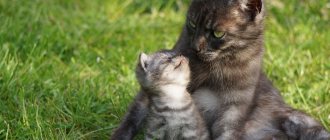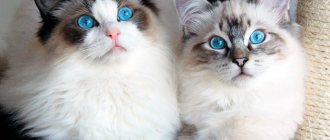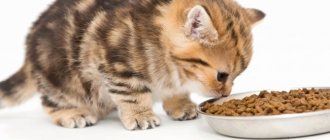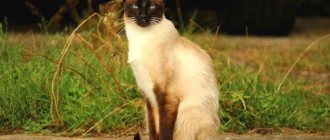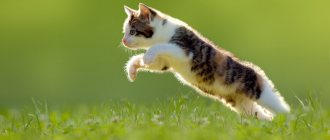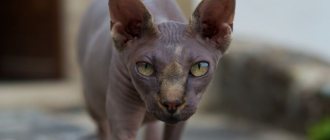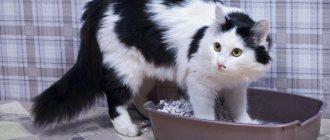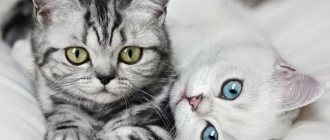What determines the weight of a kitten at birth?
When correlating the weight of a newborn pet with the norm, you need to consider the following factors:
- cat nutrition during pregnancy - the diet should contain proteins, fats and carbohydrates in acceptable proportions and quantities, but also foods rich in calcium, phosphorus and fatty acids;
- heredity - large animals often give birth to the same offspring;
- breed - Maine Coons and Ragdolls, for example, give birth to larger kittens than outbred cats;
- gender – males weigh more than females;
- the number of kittens in the litter - the more kittens a cat has, the less they weigh;
- the health status of a newborn pet - a baby who was born weak or picked up an infection from the mother in the womb or in the first days of life does not gain weight well.
Diseases leading to obesity
Obesity in cats can be caused by hormonal imbalance, poor heredity or diseases that disrupt metabolism. But in practice, such health problems are isolated cases. Much more often lead to obesity:
- poor nutrition. If a cat's diet is too high in calories, the animal may not have time to burn calories, which turn into fat. Uncontrolled eating is also harmful. Not all cats can independently regulate the amount of food they need, so monitor the frequency of feeding and portion sizes;
- sedentary lifestyle. A lazy cat simply hoards calories. Outdoor games will help here;
- castration. Castration can cause hormonal imbalances that lead to weight gain.
It's better not to wait for the cat to turn into a ball
Obesity is much easier to prevent than to treat. Excess weight worsens the quality of life of an animal, which gradually leads to diseases. Some of the consequences of obesity in cats include:
- heart failure;
- urolithiasis disease;
- diabetes;
- diseases of the musculoskeletal system;
- metabolic disorders and much more.
How to weigh kittens?
Ideally, the kitten should be weighed on special scales, which are used in veterinary clinics and most accurately indicate the weight. However, you can do this with a simple kitchen scale. When the pet becomes too active and becomes more difficult to keep in place, it is weighed on a floor scale. To do this, the owner needs to weigh himself, then pick up the animal and stand on the scale with it, and then subtract the person’s weight from the resulting figure.
In the first month of life, it is necessary to weigh the baby every week, then monthly or as needed, for example during illness. For convenience, especially if there are several pets living in the house, you should keep a notebook to record data on the pet’s development. In addition to information about weight, you can record the dates of vaccinations and antiparasitic treatments. This helps to more closely monitor the health of the animal and promptly eliminate emerging pathologies.
Why do you need a weight diary?
A caring owner must keep a diary of the kitten’s weight, regardless of whether the kitten is raised alone or with a cat mother. Weight in cats often becomes an indicator of their health, especially for growing kittens. The weight diary tracks the normal development of the pet and promptly alerts you to health problems.
If in the first months the kitten stops gaining weight, this may be a signal of malnutrition or illness. A stop in the baby's weight gain may also indicate problems in a nursing cat: perhaps she does not have enough milk.
A weight diary can provide useful clues in other cases, for example:
- calculation of the daily dose of feed. If you get a kitten whose age is unknown, weighing it will help you find out how much food it needs;
- calculation of drug dosage. Many medications for animals must be used taking into account the weight of the animal. This is especially true for anthelmintic drugs;
A weight diary will tell you whether to take your cat on a trip
- trips. Conditions for air travel with a pet depend on its weight. If the cat is small, you can take it with you to the salon. Large pets are waiting for the luggage compartment, in which the animal can become stressed. Weight information will help you assess the risks of travel for your furry friend.
Table of normal weight indicators for kittens of different breeds under the age of 1 month
At this age, babies gradually wean themselves from their mother, crawl out of hiding for a short time, and are just learning to walk, but sleep most of the time. For harmonious development, it is important to provide them with enhanced nutrition. In the first weeks of kittens’ lives, it is necessary to monitor the mother’s lactation, and subsequently, gradually introduce complementary foods in the form of fermented milk products and milk porridge into the babies’ diet. The weight norms (in g) of kittens in the first weeks of life are shown in the table:
| Age | mongrel cat | Bengal cat | British shorthair cat | Abyssinian cat | Maine Coon |
| Newborn pet | 70–130 | 70–120 | 60–140 | 85–110 | 120–160 |
| 1 Week | 85–200 | 170–200 | 110–260 | 100–200 | 180–260 |
| 2 week | 220–285 | 150–280 | 150–400 | 170–220 | 280–360 |
| 3 week | 225–400 | 200–350 | 210–630 | 200–280 | 420–600 |
| 4 week | 285–500 | 400–500 | 250–740 | 300–370 | 560–750 |
Weight gain in the first month
The first four weeks of life are characterized by the most intensive growth. The weight of a kitten in the 1st month can increase up to 15 g every day. At the end of this period, it can be two or even three times greater than at birth. Such intensive growth is noticeable to the naked eye. If at this age there is a slight gain in body weight, then you need to seek help from a veterinarian to diagnose and correct the situation.
In the first month, the kitten needs intensive care and good nutrition. The optimal diet is provided by mother's breast milk. However, a cat cannot always feed its offspring for various reasons. In this case, the role of “mother” falls on the pet owner. The best substitute for mother's milk are special industrial mixtures, the composition of which duplicates the natural components as much as possible. The dosage and frequency of feeding depend on the age and size of the animal. So, in the first week he should be fed about 4 ml every 2-4 hours, and in the second week - every 4-6 hours, 5 ml. With proper nutrition, by the end of the fourth week he will weigh 300-400 g, his first teeth will grow and he can already be given additional food.
In addition to rapid growth, signs of your pet’s health in the first four weeks of life will include:
- ability to stand on one’s paws (way and not confidently);
- active behavior;
- healthy sleep;
- regular bowel movements.
Weight indicators for 2–6 month old kittens of different breeds
Unlike the build of a one-month-old kitten, which largely depends on the characteristics of intrauterine development, at this age lifestyle and nutrition increasingly begin to influence the baby’s weight. Naturally, pets that spend a lot of time outside with other kittens from the first months of life weigh slightly less than their domestic counterparts. At this age, differences in weight between representatives of different breeds become increasingly noticeable.
For example, a healthy two-month-old kitten of a regular breed weighs 0.8–1.5 kg, Persian – 0.56–1.2, Siamese – 0.52–1.6, Neva Masquerade – 0.46–1.4, Don Sphynx – 0.51–0.82 kg. A normally developing three-month-old outbred cat weighs 2–2.3, and its peers of the above breeds weigh 1–2, 0.9–2, 1–2.8, 0.9–2.2, 0.9–2 kg, respectively . Over the following months, the kittens become less playful, although they still eagerly respond to the offer to play. By 5–6 months, the weight of a purebred kitten is 2.5–3.8, Persian – 2–4.3, Siamese – 1.7–4, Neva Masquerade – 2.3–5.6, Sphynx – 2–3, 8 kg.
Why is the baby overweight and is it dangerous?
At this age, this problem is most often associated with overeating and insufficient physical activity. In most cases, this disorder is diagnosed in domestic cats that do not walk outside.
Most often, the problem of excess weight is solved by reducing portions. As a rule, at 7–9 months, at the height of puberty, the cat’s weight returns to normal. Much less often, obesity becomes a consequence of systemic diseases. To determine whether excess weight indicates pathology, you need to examine the kitten's waist. Normally, the ribs should not be noticeable, but easily palpable. If your fingers “sink” when you feel them, it is difficult for the animal to move, it is lethargic and apathetic, you need to contact a veterinarian.
Source
Visual inspection
To determine the condition of the animal, it is necessary to carefully examine its physique. The condition of the limbs and abdomen is determined when looking at the profile, the lumbar region and waist are assessed when viewed from above. The weight of a cat can also be “calculated” by manual palpation. To do this, the area of the ribs is felt with your fingers. Moreover, if the bones stick out at the slightest pressure, then the animal is malnourished; if you need to make an effort to palpate them, then, most likely, the pet is obese.
After the ribs, the waist and abdomen area is assessed. In cats, it is very sensitive, so you must be careful when palpating. If you run two palms from the waist to the pelvic bones, you should get an hourglass shape. If this sensation does not arise, then the cat is most likely overweight.
Next, the abdomen is examined. Softness should be felt under your fingers. But if it hangs down a lot or is swollen, then nutritional adjustments are necessary. A sunken belly indicates a lack of nutrition or illness.
Body weight standards for cats by age
The body weight of purebred cats and those representatives of the cat world who do not have a breed is somewhat different. For example, we take the weight indicators of a purebred animal and a British breed cat (on a mobile phone, you can scroll the table horizontally with your finger):
| Age | No breed - weight in grams | British cat - weight in grams |
| Up to 30 days from birth | from 80 to 120 | from 120 to 160 |
| 1 month | from 320 to 500 | from 500 to 800 |
| 2 months | from 450 to 800 | from 800 to 1200 |
| 3 months | from 900 to 1100 | 1400 – 1900 |
| 5 months | from 2000 to 2500 | 2800 – 3600 |
| 7 months | from 2600 to 3000 | 4500 – 5600 |
| 8 months | from 3500 to 4400 | 6100 – 7100 |
| 12 months | from 4600 to 5400 | 7500 – 8300 |
| Adult animal | 5300 – 6400 | 8000 – 10 kg |
| After sterilization/castration | 5500 – 6800 | 9 kg – 13 kg. |
It is generally believed that the largest domestic cat by weight is the Maine Coon, but this is not true. Representatives of this breed only look visually larger due to the large amount of long and lush hair.
But if you compare their weight, you can see that an adult cat of the British breed, and especially after sterilization or castration, will weigh significantly more than a Maine Coon:
Why define?
When a baby is born, one of the first indicators that is noted is its weight. Good weight is the first sign of health. Not the only one, but one of the most important. It's the same with animals. There are weight standards that correspond to each cat breed. Basically they are about the same when the kitten is just born. As adults, norms change. Determining and monitoring weight throughout your pet's life is mandatory. By weight, you can determine overfeeding or underfeeding, an impending or progressive disease, or development.
When born from the same mother, you can compare the weight of kittens even without special instruments. Just looking at them is enough. If the kitten is thinner than the others, then special monitoring is required: behavior, feeding, sleep. If it is visually unclear that the kitten is thinner than the others, then you can watch how he attaches to the breast.
If other, stronger kittens push him away, then you need to take the kitten and bring it to the cat yourself, and more often than the others eat.
Table of norms and weight deviations for cats of different breeds
Body weight directly depends on the constitution of the animal. Like people, some cats have a slight figure, others can boast of medium size, and still others will initially be quite large. Therefore, before running to the veterinarian, you need to determine, taking into account the breed, whether your pet has weight problems (overweight or underweight).
Table of body weight of an adult pet with a slight build, depending on the breed, weight is indicated in kilograms (on a mobile phone, the table can be scrolled horizontally with your finger):
| Breed | Normal indicator | Slight excess | Risk of Obesity |
| Abyssinian | 3.4 | 3.7 | 4.1 |
| American Bobtail | 4.0 | 4.4 | 4.8 |
| Angora | 3.2 | 3.5 | 3.8 |
| Balinese | 3.1 | 3.4 | 3.7 |
| Bengal | 4.0 | 4.4 | 4.8 |
| Burma | 3.6 | 4.0 | 4.3 |
| Bombay | 3.6 | 4.0 | 4.3 |
| British Shorthair | 3.8 | 4.2 | 4.6 |
| Burmanskaya | 3.1 | 3.4 | 3.7 |
| Burmilla | 3.4 | 3.7 | 4.1 |
| Havana Brown | 3.2 | 3.5 | 3.8 |
| Himalayan | 3.8 | 4.2 | 4.6 |
| Devon Rex | 2.8 | 3.1 | 3.4 |
| Egyptian Mau | 3.0 | 3.3 | 3.6 |
| Cymric | 3.5 | 3.8 | 4.2 |
| Cornish Rex | 2.7 | 2.9 | 3.2 |
| Korat | 3.2 | 3.5 | 3.8 |
| Manx | 3.5 | 3.8 | 4.2 |
| Munchkin | 3.2 | 3.6 | 3.9 |
| Maine Coon | 5.8 | 6.4 | 7.0 |
| Nibelung | 2.5 | 2.8 | 3.0 |
| Norwegian forest | 3.2 | 3.6 | 3.9 |
| Oriental | 3.0 | 3.3 | 3.6 |
| Ocicat | 4.4 | 4.8 | 5.3 |
| Persian | 3.8 | 4.2 | 4.6 |
| Russian blue | 2.5 | 2.8 | 3.0 |
| Ragdoll | 5.0 | 5.5 | 6.0 |
| Selkirk Rex | 3.6 | 4.0 | 4.4 |
| Siamese | 3.1 | 3.4 | 3.7 |
| Siberian | 4.0 | 4.4 | 4.8 |
| Singaporean | 2.5 | 2.7 | 3.0 |
| Snow-shoe | 3.4 | 3.7 | 4.1 |
| Somalia | 3.2 | 3.6 | 3.9 |
| Sphinx | 3.4 | 3.7 | 4.1 |
| Tiffany | 4.0 | 4.4 | 4.8 |
| Tonkinese | 3.5 | 3.8 | 4.2 |
| Turkish Angora | 3.3 | 3.6 | 3.9 |
Table of body weights for cats that are of average build from birth (on a mobile device you can scroll the table horizontally with your finger):
| Breed | Normal indicator | Slight excess | Risk of Obesity |
| Abyssinian | 4.3 | 4.7 | 5.1 |
| American Bobtail | 5.0 | 5.5 | 6.0 |
| Angora | 4.0 | 4.4 | 4.8 |
| Balinese | 3.9 | 4.2 | 4.6 |
| Bengal | 5.0 | 5.5 | 6.0 |
| Burma | 4.5 | 5.0 | 5.4 |
| Bombay | 4.5 | 5.0 | 5.4 |
| British Shorthair | 4.8 | 5.2 | 5.7 |
| Burmanskaya | 3.9 | 4.2 | 4.6 |
| Burmilla | 4.3 | 4.7 | 5.1 |
| Havana Brown | 4.0 | 4.4 | 4.8 |
| Himalayan | 4.8 | 5.2 | 5.7 |
| Devon Rex | 3.6 | 3.9 | 4.3 |
| Egyptian Mau | 3.8 | 4.1 | 4.5 |
| Cymric | 4.4 | 4.8 | 5.2 |
| Cornish Rex | 3.4 | 3.7 | 4.0 |
| Korat | 4.0 | 4.4 | 4.8 |
| Manx | 4.4 | 4.8 | 5.2 |
| Munchkin | 4.1 | 4.5 | 4.9 |
| Maine Coon | 7.3 | 8.0 | 8.8 |
| Nibelung | 3.2 | 3.5 | 3.8 |
| Norwegian forest | 4.1 | 4.5 | 4.9 |
| Oriental | 3.7 | 4.1 | 4.4 |
| Ocicat | 5.5 | 6.1 | 6.6 |
| Persian | 4.8 | 5.2 | 5.7 |
| Russian blue | 3.2 | 3.5 | 3.8 |
| Ragdoll | 6.3 | 6.9 | 7.5 |
| Selkirk Rex | 4.6 | 5.0 | 5.5 |
| Siamese | 3.9 | 4.2 | 4.6 |
| Siberian | 5.0 | 5.5 | 6.0 |
| Singaporean | 3.1 | 3.4 | 3.7 |
| Snow-shoe | 4.3 | 4.7 | 5.1 |
| Somalia | 4.1 | 4.5 | 4.9 |
| Sphinx | 4.3 | 4.7 | 5.1 |
| Tiffany | 5.0 | 5.5 | 6.0 |
| Tonkinese | 4.4 | 4.8 | 5.2 |
| Turkish Angora | 4.1 | 4.5 | 4.9 |
| Turkish Van | 5.0 | 5.5 | 6.0 |
| Chartreuse | 4.8 | 5.3 | 5.8 |
| Scottish lop-eared | 5.0 | 5.5 | 6.0 |
| Exotic Shorthair | 4.8 | 5.2 | 5.7 |
| Javanesian | 3.6 | 3.9 | 4.3 |
| Japanese Bobtail | 3.6 | 3.9 | 4.3 |
How much should a cat weigh depending on age and breed?
As pets who have been spayed and neutered age, they gain weight in a short period of time. An animal diagnosed with obesity moves little, becomes less playful, has difficulty doing common cat activities like jumping on a windowsill, and has health problems.
Excess weight is a frequent companion to joint diseases, heart problems, shortness of breath and other ailments.
It is impossible to determine the normal weight of an animal only by the number when weighing, because cats, depending on the breed and according to age, weigh differently. The tables below reflect the weight of an average-sized cat.
Table of optimal weight of kittens up to a month:
| Kitten breed name | Newborn (gr.) | 2 weeks (gr.) | 1 Month (gr.) |
| Siamese | 90-140 | 180-260 | 500-700 |
| Persian | 95-140 | 310-380 | 400-500 |
| British | 70-140 | 340-400 | 550-740 |
| Maine Coon | 120-160 | 300-360 | 630-750 |
| Yard (mongrel) | 60-130 | 240-430 | 450-650 |
Weight table for adults aged 1 year and older:
| Breed name | Adult weight | Weight of casted/sterilized cat |
| Siamese | 5.5-6 kg | 6-6.5kg |
| Persian | 5.4-5.5kg | 5.6-6kg |
| British Shorthair | 5.4-6.1kg | 5.8-6.4kg |
| Maine Coon | 5.4-6.7kg | 6.2-7.5kg |
| Yard (mongrel) | 5.2-6.4kg | 5.4-6.9kg |
Signs of normality and deviations in weight up or down
In order to determine without weighing an animal whether its body weight is within the normal range, or whether it is obese or, conversely, exhausted, you need to take a close look at the animal and examine its body.
Signs of being underweight:
- the bones of the ribs and pelvis are clearly visible, protruding excessively through the skin;
- visible insufficiency of muscle fibers;
- When palpating the chest, a layer of subcutaneous fat is not felt.
Maximum low limit of permissible low weight:
- the bones of the ribs and pelvis are clearly distinguished;
- the waist is visible;
- in the chest area you can feel the subcutaneous fat layer, which is absent on the abdomen.
The norm indicator, which is considered ideal for an animal of any breed:
- all body proportions are perfectly observed;
- the bones of the ribs and pelvis are poorly visible, but they can be felt;
- the waist varies;
- the presence of subcutaneous fat in the chest area;
- There is a small, thin accumulation of subcutaneous fat on the abdomen.
Signs indicating that an animal has problems with excess weight:
- it is extremely difficult to palpate the bones of the pelvis, ribs and spinal column;
- it is almost impossible to determine the waist;
- the layer of subcutaneous fat can be easily felt in the chest and abdomen.
- due to the thick layer of fat, it is almost impossible to feel the bones of the pelvis and hips and the spinal column with your hands;
- the fat layer under the skin on the chest and abdomen is thick;
- the abdomen is enlarged.
With a lack or excess of weight, the animal’s behavior also changes. The cat becomes apathetic and prefers to spend most of its time lying down. With obesity and underweight, it is difficult for an animal to move.
Normal weight cat
An animal with normal weight has a harmoniously built body and a clearly defined waist. If you look at a cat from above, its body resembles an hourglass. The ribs are palpable, but do not protrude and are devoid of a large layer of fat. The side view shows a well-toned abdomen.
However, during a visual inspection, the characteristics of the breed should be taken into account. While some cats look sophisticated, others are always heavy and stocky. It happens that the breed standard does not exclude the presence of a small abdominal fold.
What to do if your pet's weight is not normal
If the animal is obese or underweight, it must be shown to a veterinarian. Problems with a pet’s weight (deviation up or down) are a sign that some diseases and pathological processes are developing in the body. Although the owner himself may be to blame for incorrectly organizing the diet and feeding regime of his pet.
To solve the problem of excess weight, it is recommended to switch the animal to specialized industrial feeds, which are well saturated and at the same time have minimal calorie content. Ensuring an active lifestyle also plays an important role: you need to play outdoor games with your pet as often as possible so that it expends energy, and with it the fat layer is burned.
It is also necessary to change the diet if the animal is underweight. Products must be high in calories. Owners are advised to focus on specialized industrial feeds, which not only have the necessary calorie content, but also contain vitamins and minerals. Lack of weight requires a thorough diagnosis of the pet's health condition and appropriate treatment.
Source
Lack of weight and its causes
If a cat's hip bones and ribs are visible, and the spine has a minimal layer of fat, then the animal is underweight. At the same time, the neck is thin, the stomach is sunken and the limbs have an unhealthy appearance. In this case, the pet should be shown to a specialist to prescribe therapeutic nutrition and clarify the problem. Worms are often the cause of weight loss.
Lack of weight can be determined by the following signs:
- protruding ribs, easily palpable when stroking;
- the layer of fat is minimal or completely absent;
- muscle mass is difficult to palpate;
- vertebrae are visible;
- the abdominal fold is difficult to palpate, the abdomen is sunken.
